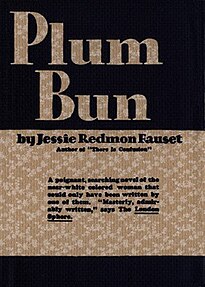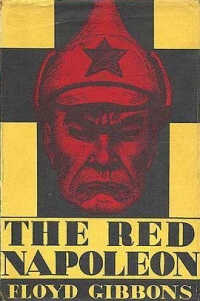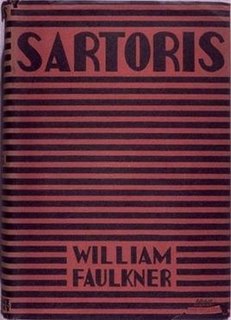 W
WAfter 12,000 Years is a science fiction novel by American writer Stanton A. Coblentz. It was first published in book form in 1950 by Fantasy Publishing Company, Inc. (FPCI) in an edition of 1,000 copies, of which 750 were hardback. Lloyd Arthur Eshbach regarded this as one of the stronger titles published by FPCI. Considered one of the author's most bizarre and most interesting futuristic fantasies, the novel originally appeared in the Spring 1929 issue of the magazine Amazing Stories Quarterly. The novel was abridged for the FPCI publication. E. F. Bleiler considered the unabridged version to be superior.
 W
WThe Black Camel (1929) is the fourth of the Charlie Chan novels by Earl Derr Biggers.
 W
WThe Blacker the Berry: A Novel of Negro Life (1929) is a novel by American author Wallace Thurman, associated with the Harlem Renaissance. The novel tells the story of Emma Lou Morgan, a young black woman with dark skin. It begins in Boise, Idaho and follows Emma Lou in her journey to college at USC and a move to Harlem, New York City for work. Set during the Harlem Renaissance, the novel explores Emma Lou's experiences with colorism, discrimination by lighter-skinned African Americans due to her dark skin. She learns to come to terms with her skin color in order to find satisfaction in her life.
 W
WThe Bridge of Light is a science fiction novel by American writer A. Hyatt Verrill. It was originally published in the Fall 1929 edition of the pulp magazine Amazing Stories Quarterly. It was subsequently republished in book form in 1950 by Fantasy Press in an edition of 2,556 copies.
Cup of Gold: A Life of Sir Henry Morgan, Buccaneer, with Occasional Reference to History (1929) was John Steinbeck's first novel, a work of historical fiction based loosely on the life and death of 17th-century privateer Henry Morgan. It centres on Morgan's assault and sacking of Panama City, and the woman he seeks there, reputed to be fairer than the sun.
 W
WThe Dain Curse is a novel by Dashiell Hammett, published in 1929. Before its publication in book form, it was serialized in Black Mask magazine in 1928 and 1929.
 W
WDaughter of Earth (1929) is an autobiographical novel by the American author and journalist Agnes Smedley. The novel chronicles the years of Marie Rogers's tumultuous childhood, struggles in relationships with men, time working with the Socialist Party, and involvement in the Indian independence movement.
 W
WDodsworth is a satirical novel by American writer Sinclair Lewis, first published by Harcourt Brace & Company in March 1929. Its subject, the differences between US and European intellect, manners, and morals, is one that frequently appears in the works of Henry James.
 W
WA Farewell to Arms is a novel by Ernest Hemingway set during the Italian campaign of World War I. First published in 1929, it is a first-person account of an American, Frederic Henry, serving as a lieutenant ("tenente") in the ambulance corps of the Italian Army. The title is taken from a poem by the 16th-century English dramatist George Peele.
 W
WGods' Man is a wordless novel by American artist Lynd Ward (1905–1985) published in 1929. In 139 captionless woodblock prints, it tells the Faustian story of an artist who signs away his soul for a magic paintbrush. Gods' Man was the first American wordless novel, and is considered a precursor of the graphic novel, whose development it influenced.
 W
WHitty, Her First Hundred Years is a children's novel written by Rachel Field and published in 1929. It won the Newbery Medal for excellence in American children's literature in 1930. The book is told from the point of view of an inanimate doll named Hitty, who was constructed in the 1820s and has since traveled around the world, through many different owners.
 W
WJack Pumpkinhead of Oz (1929) is the twenty-third of the series of Oz books created by L. Frank Baum and continued by other writers; it is the ninth Oz book written by Ruth Plumly Thompson. It was Illustrated by John R. Neill.
 W
WLaughing Boy is a 1929 novel by Oliver La Farge about the struggles of the Navajo in Southwestern United States to reconcile their culture with that of the United States. It won the Pulitzer Prize in 1930.
 W
WLook Homeward, Angel: A Story of the Buried Life is a 1929 novel by Thomas Wolfe. It is Wolfe's first novel, and is considered a highly autobiographical American coming-of-age story. The character of Eugene Gant is generally believed to be a depiction of Wolfe himself. The novel briefly recounts Eugene's father's early life, but primarily covers the span of time from Eugene's birth in 1900 to his definitive departure from home at the age of 19. The setting is a fictionalization of his home town of Asheville, North Carolina, called Altamont, Catawba in the novel.
 W
WMagnificent Obsession is a 1929 novel by Lloyd C. Douglas. It was one of four of his books that were eventually made into blockbuster motion pictures, the other three being The Robe, White Banners and The Big Fisherman.
 W
WThe Monster Men is a 1913 science fiction novel by American author Edgar Rice Burroughs, written under the working title "Number Thirteen". It first appeared in print under the title of "A Man Without a Soul" in the November, 1913 issue of All-Story Magazine, and was first published in book form in hardcover by A. C. McClurg in March, 1929 under the present title. It has been reissued a number of times since by various publishers. The first paperback edition was issued by Ace Books in February 1963.
 W
WThe Mystery Of Cabin Island is Volume 8 in the original The Hardy Boys Mystery Stories published by Grosset & Dunlap. This book was written for the Stratemeyer Syndicate by Leslie McFarlane in 1929. Between 1959 and 1973 the first 38 volumes of this series were systematically revised as part of a project directed by Harriet Adams, Edward Stratemeyer's daughter. The original version of this book was rewritten in 1966 by Anne Shultes resulting in two different stories with the same title.
 W
WPassing is a novel by American author Nella Larsen, first published in 1929. Set primarily in the Harlem neighborhood of New York City in the 1920s, the story centers on the reunion of two childhood friends—Clare Kendry and Irene Redfield—and their increasing fascination with each other's lives. The title refers to the practice of "racial passing", and is a key element of the novel; Clare Kendry's attempt to pass as white for her husband, John (Jack) Bellew, is its most significant depiction in the novel, and a catalyst for the tragic events.
 W
WPenrod Jashber is the third novel in a series by Booth Tarkington about the adventures of Penrod Schofield, an 11-year-old middle-class boy in a small city in the Midwest.
 W
WThe Planet of Peril, later republished as Planet of Peril, is a 1929 science fiction novel by Otis Adelbert Kline. Originally serialized in six parts in Argosy All-Story Weekly during the summer of 1929, it was published in hardcover later that year by A. C. McClurg and reissued in a lower-price edition by Grosset & Dunlap. It was revived in 1961 as an Avalon Books hardcover and saw its only mass market paperback edition from Ace Books in 1963. The later editions, well after Kline's death, were revised and shortened.
 W
WPlum Bun: A Novel Without a Moral is a novel by Jessie Redmon Fauset first published in 1928. Written by an African-American woman who, during the 1920s, was for many years the literary editor of The Crisis, it is often seen as an important contribution to the movement that has come to be known as the Harlem Renaissance.
 W
WRed Harvest (1929) is a novel by Dashiell Hammett. The story is narrated by the Continental Op, a frequent character in Hammett's fiction, much of which is drawn from his own experiences as an operative of the Pinkerton Detective Agency. The labor dispute in the novel was inspired by Butte's Anaconda Road massacre.
 W
WThe Red Napoleon is a 1929 novel by Floyd Gibbons predicting a Soviet conquest of Europe and invasion of America. The novel contains strong racial overtones such as expressed fear of the yellow peril and of inter-racial breeding. However, the characters expressing these views are exposed in the text as being bigoted and ill-informed, as is one of the main U.S. character's views of the Soviet Union's free-love-but-with-male-accountability laws.
 W
WThe Roman Hat Mystery is a novel that was written in 1929 by Ellery Queen. It is the first of the Ellery Queen mysteries.
 W
WSartoris is a novel, first published in 1929, by the American author William Faulkner. It portrays the decay of the Mississippi aristocracy following the social upheaval of the American Civil War. The 1929 edition is an abridged version of Faulkner's original work. The full text was published in 1973 as Flags in the Dust. Faulkner's great-grandfather William Clark Falkner, himself a colonel in the American Civil War, served as the model for Colonel John Sartoris. Faulkner also fashioned other characters in the book on local people from his hometown Oxford. His friend Ben Wasson was the model for Horace Benbow, while Faulkner's brother Murry served as the antetype for young Bayard Sartoris.
 W
WThe Scarab Murder Case (1929) is a classic whodunit written by S. S. Van Dine. In this book, detective Philo Vance's murder investigation takes place in a private home that doubles as a museum of Egyptology, and the solution depends in part on Vance's extensive knowledge of Egyptian history and customs, which enable him to sort through suggestions of godly vengeance and reveal the misdirections perpetrated by the real murderer.
 W
WThe Secret of the Caves is Volume 7 in the original The Hardy Boys Mystery Stories published by Grosset & Dunlap.
 W
WThe Sound and the Fury is a novel by the American author William Faulkner. It employs several narrative styles, including stream of consciousness. Published in 1929, The Sound and the Fury was Faulkner's fourth novel, and was not immediately successful. In 1931, however, when Faulkner's sixth novel, Sanctuary, was published—a sensationalist story, which Faulkner later said was written only for money—The Sound and the Fury also became commercially successful, and Faulkner began to receive critical attention.
 W
WTal: His Marvelous Adventures with Noom-Zor-Noom is a children's fantasy novel by Paul Fenimore Cooper, illustrated by Ruth Reeves, and published by William Morrow in 1929. New editions were published in 1957 by Stephen Daye Press and in 2001 by Purple House Press. The story features an orphan who goes on a quest to the land of Troom with a wise storyteller, Noom-Zor-Noom, and his talking donkey.
 W
WTanar of Pellucidar is a novel by American writer Edgar Rice Burroughs, the third in his series set in the interior world of Pellucidar. It first appeared as a six-part serial in The Blue Book Magazine from March–August 1929. It was first published in book form in hardcover by Metropolitan Books in May 1930.
 W
WTarzan and the Lost Empire is a novel by American writer Edgar Rice Burroughs, the twelfth in his series of twenty-four books about the title character Tarzan. It was first published as a serial in Blue Book Magazine from October 1928 through February 1929; it first appeared in book form in a hardcover edition from Metropolitan Newspaper Services in September 1929. This was the first Edgar Rice Burroughs book not published by A. C. McClurg, with whom Burroughs had cut off business ties due to a dispute over royalties.
 W
WThe Trumpeter of Krakow, a young adult historical novel by Eric P. Kelly, won the Newbery Medal for excellence in American children's literature in 1929.